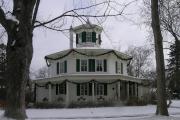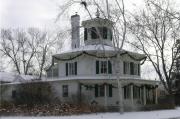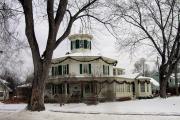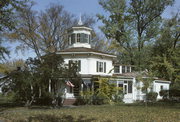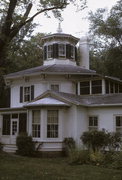Property Record
1004 3RD ST
Architecture and History Inventory
| Historic Name: | John S. Moffat House |
|---|---|
| Other Name: | ST. CROIX COUNTY HISTORICAL SOCIETY |
| Contributing: | Yes |
| Reference Number: | 24024 |
| Location (Address): | 1004 3RD ST |
|---|---|
| County: | St. Croix |
| City: | Hudson |
| Township/Village: | |
| Unincorporated Community: | |
| Town: | |
| Range: | |
| Direction: | |
| Section: | |
| Quarter Section: | |
| Quarter/Quarter Section: |
| Year Built: | 1855 |
|---|---|
| Additions: | 1916 1860 |
| Survey Date: | 1983 |
| Historic Use: | house |
| Architectural Style: | Octagon |
| Structural System: | |
| Wall Material: | Stucco |
| Architect: | |
| Other Buildings On Site: | |
| Demolished?: | No |
| Demolished Date: |
| National/State Register Listing Name: | Moffat, John S., House |
|---|---|
| National Register Listing Date: | 7/18/1974 |
| State Register Listing Date: | 1/1/1989 |
| National Register Multiple Property Name: | Multiple Resources of Hudson |
| Additional Information: | A 'site file' exists for this property. It contains additional information such as correspondence, newspaper clippings, or historical information. It is a public record and may be viewed in person at the Wisconsin Historical Society, State Historic Preservation Office. PAIRED BRACKETS UNDER EAVES. ORIGINALLY BUILT IN GREEK REVIVAL STYLE. LIBRARY AND BEDROOM ADDITION WERE CONSTRUCTED IN 1860. 1916 ADDITION AND EXTERNAL DETAILS DONE IN ITALIANATE STYLE. ALSO STUCCOED IN 1916. SEE NRHPF. Western New York’s so-called “burned-over district” was a hotbed of reform zeal in the decades before the Civil War. Abolitionism, the temperance and woman’s rights movements, and Mormonism all emerged there and traveled with emigrants when they left for other regions. In fact, the many New Yorkers who came to Wisconsin during this period helped make this state another stronghold for social reform. New Yorkers’ progressive beliefs even showed up in their architecture. Octagon-shaped houses like the Moffat House enjoyed widespread popularity in the 1850s, thanks largely to their foremost proponent, the phrenologist and writer Orson Fowler, another reform-minded New Yorker (see WL16). The octagon fad spread in the early 1850s with emigration from New York, so it is no coincidence that Wisconsin boasts more octagon houses than almost any other state. Tradition holds that John Moffat patterned this 1855 octagon house after one he had admired in Ithaca, New York, which he had left a year earlier. Originally the builders clad the dwelling in clapboard, decked it with Greek Revival details, and wrapped it in a full veranda with a balustraded roof deck. But by 1860 the family lowered the roof pitch and added a magnificent rooftop belvedere with segmentally arched windows and an onion finial. Updating the design, they added Italianate details such as paired brackets under the eaves, but kept the original Doric columns and pilasters. After 1860, the Moffats added a wing and two more porches, and in 1916 their grandson stuccoed the exterior walls and removed the veranda’s balustrade. Today the building houses the St. Croix County Historical Society’s museum as it has since 1964. |
|---|---|
| Bibliographic References: | OCTAGON HOUSES IN WISCONSIN, P.5 MINNESOTA HOUSES, KENNEDY. ARCHITECTURE IN CHICAGO AND MID-AMERICA, ANDREWS. NEW RICHMOND NEWS 6/29/1995. HAMMOND CENTRAL ST. CROIX NEWS 6/28/1995. Hudson Star Observer, Christmas Tour of Homes, 11/23-24/1996. Wisconsin Magazine of History 9/1944. Central St. Croix News, Hammond 8/19/1980. Buildings of Wisconsin manuscript. |
| Wisconsin Architecture and History Inventory, State Historic Preservation Office, Wisconsin Historical Society, Madison, Wisconsin |

